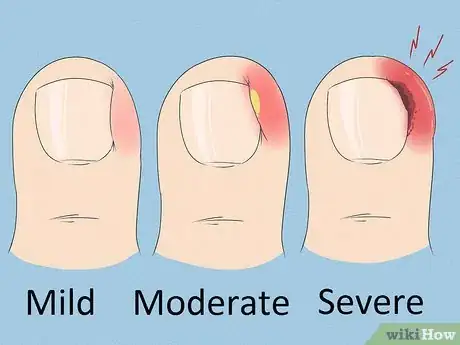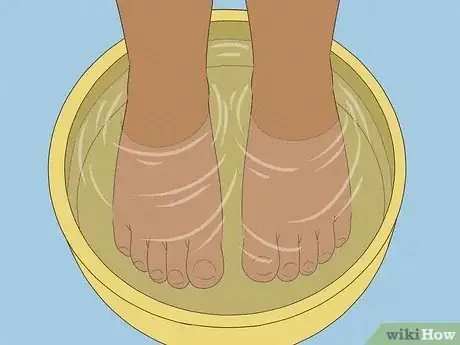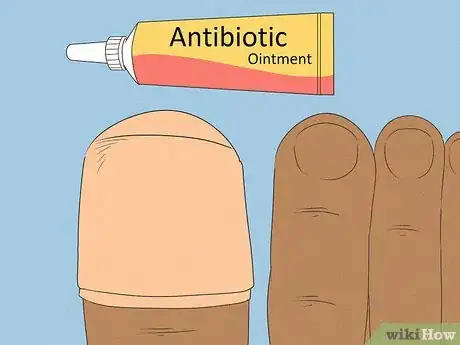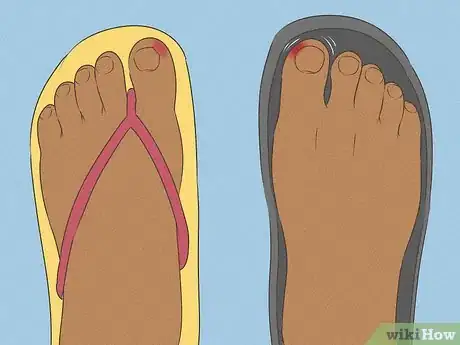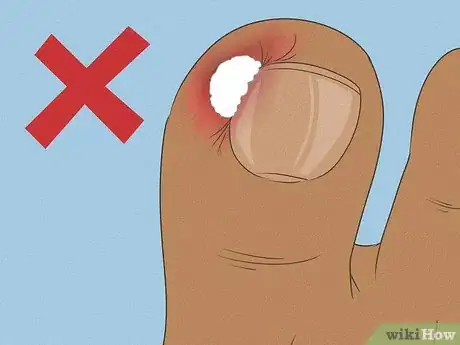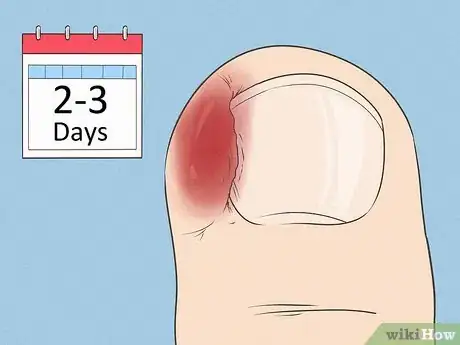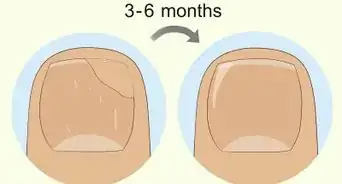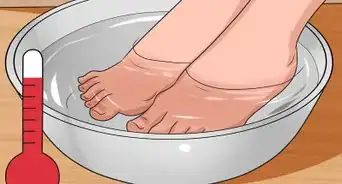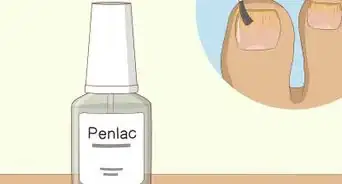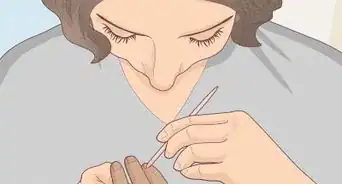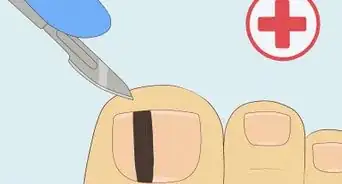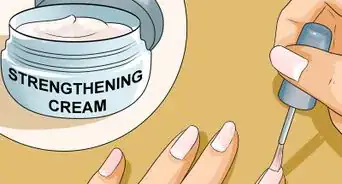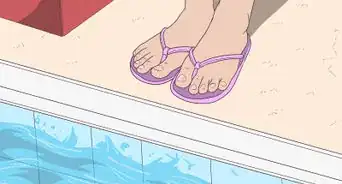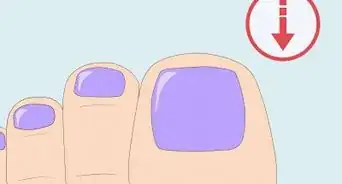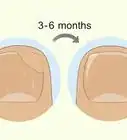This article was co-authored by Mark Co, DPM and by wikiHow staff writer, Sophia Latorre. Dr. Mark Co is a Podiatrist who runs his own private practice in San Francisco, California. Dr. Co specializes in treatments for bunions, ingrown toenails, toenail fungus, warts, plantar fasciitis and other causes of foot pain. He also offers custom orthotics for the treatment and prevention of foot and ankle issues. Dr. Co completed a Master of Business Administration (MBA) at New York University and an MA in Electrical Engineering and Computer Science at Johns Hopkins University. Dr. Co also completed his DPM at the California School of Podiatric Medicine and a residency and internship at the Kaiser Permanente Medical Center, Santa Clara, California. Dr. Co was awarded San Francisco's "Top 3 Podiatrists" in 2018, 2019, and 2020. Dr. Co is also a member of the CPMA (American Podiatric Medical Association).
There are 14 references cited in this article, which can be found at the bottom of the page.
This article has been viewed 52,450 times.
Ingrown toenails are really common, but that doesn’t make them any less of a pain—literally. Will an ingrown toenail heal itself? If not, how should you treat it? We’ve done the research for you and will answer these questions and more below. Keep reading to find out the best ingrown toenail treatments.
Steps
How do you get rid of an ingrown toenail at home?
-
1Soak your foot in warm water. Soak your affected foot in warm water for 15-20 minutes 3-4 times per day.[9] This helps soften the skin and nail and reduces swelling and pain.[10]
-
2Apply an antibiotic ointment if the problem worsens. If you notice increased redness or swelling, an antibiotic ointment may help prevent an infection. After soaking your toe, let it dry, then apply an over-the-counter antibiotic ointment to the problem area.[13] You can cover the toe with a bandage, as well.[14]
-
3Wear comfortable shoes that fit well. Shoes that are too tight or pinch your toes can cause ingrown toenails and make existing problems worse. If you’re dealing with an ingrown toenail, opt for sandals or other open-toed shoes if you can. If you need to wear close-toed shoes, pick a pair with enough room in the toe box for you to wiggle your toes.[15]
-
4Avoid putting cotton underneath the nail. Many websites suggest lifting up the corner of the nail and putting a piece of cotton underneath it to prevent the nail from digging into your skin. However, the American College of Foot and Ankle Surgeons advises against it. The cotton creates a perfect home for bacteria, which increases the likelihood that your ingrown toenail will get infected.[16]
When should you go to the doctor for an ingrown toenail?
-
1
-
2Make a doctor’s appointment if your toenail is infected. It’s quite common for ingrown toenails to become infected, and an infection needs medical treatment. If your ingrown toenail is red, swollen, and painful and you notice pus or other discharge, visit a doctor so they can prescribe antibiotics to treat the infection.[21]
-
3Get medical treatment if you have diabetes or another health condition. Avoid trying to treat an ingrown toenail at home if you have poor blood circulation, nerve problems in your legs or feet, or diabetes. Instead, see your primary care provider or a podiatrist right away.[22]
References
- ↑ https://orthoinfo.aaos.org/en/diseases--conditions/ingrown-toenail
- ↑ https://health.clevelandclinic.org/how-you-can-prevent-and-treat-painful-ingrown-toenails/
- ↑ https://www.nhsinform.scot/illnesses-and-conditions/skin-hair-and-nails/ingrown-toenail
- ↑ https://bpac.org.nz/BPJ/2014/December/docs/BPJ65-ingrown-toenails.pdf
- ↑ https://bpac.org.nz/BPJ/2014/December/docs/BPJ65-ingrown-toenails.pdf
- ↑ https://bpac.org.nz/BPJ/2014/December/docs/BPJ65-ingrown-toenails.pdf
- ↑ https://www.seattlechildrens.org/conditions/a-z/toenail-ingrown/
- ↑ https://www.researchgate.net/publication/26802467_Growth_rate_of_human_fingernails_and_toenails_in_healthy_American_young_adults
- ↑ Mark Co, DPM. Podiatrist. Expert Interview. 21 April 2020.
- ↑ https://www.mayoclinic.org/diseases-conditions/ingrown-toenails/diagnosis-treatment/drc-20355908
- ↑ https://health.clevelandclinic.org/how-you-can-prevent-and-treat-painful-ingrown-toenails/
- ↑ https://www.health.harvard.edu/newsletter_article/foot-health-what-to-do-about-an-ingrown-toenail
- ↑ https://www.aafp.org/afp/2002/0615/p2557.html
- ↑ https://health.clevelandclinic.org/how-you-can-prevent-and-treat-painful-ingrown-toenails/
- ↑ https://bpac.org.nz/BPJ/2014/December/docs/BPJ65-ingrown-toenails.pdf
- ↑ https://www.foothealthfacts.org/conditions/ingrown-toenail
- ↑ https://www.aad.org/public/parents-kids/healthy-habits/parents/kids/ingrown-nails
- ↑ Mark Co, DPM. Podiatrist. Expert Interview. 21 April 2020.
- ↑ Mark Co, DPM. Podiatrist. Expert Interview. 21 April 2020.
- ↑ https://orthoinfo.aaos.org/en/diseases--conditions/ingrown-toenail
- ↑ https://bpac.org.nz/BPJ/2014/December/docs/BPJ65-ingrown-toenails.pdf
- ↑ https://medlineplus.gov/ency/article/001237.htm
- ↑ https://bpac.org.nz/BPJ/2014/December/docs/BPJ65-ingrown-toenails.pdf
- ↑ Mark Co, DPM. Podiatrist. Expert Interview. 21 April 2020.
- ↑ https://bpac.org.nz/BPJ/2014/December/docs/BPJ65-ingrown-toenails.pdf
- ↑ https://www.footcaremd.org/conditions-treatments/toes/ingrown-toenail
- ↑ https://health.clevelandclinic.org/how-you-can-prevent-and-treat-painful-ingrown-toenails/
- ↑ https://health.clevelandclinic.org/how-you-can-prevent-and-treat-painful-ingrown-toenails/
- ↑ https://medlineplus.gov/ency/article/001237.htm
